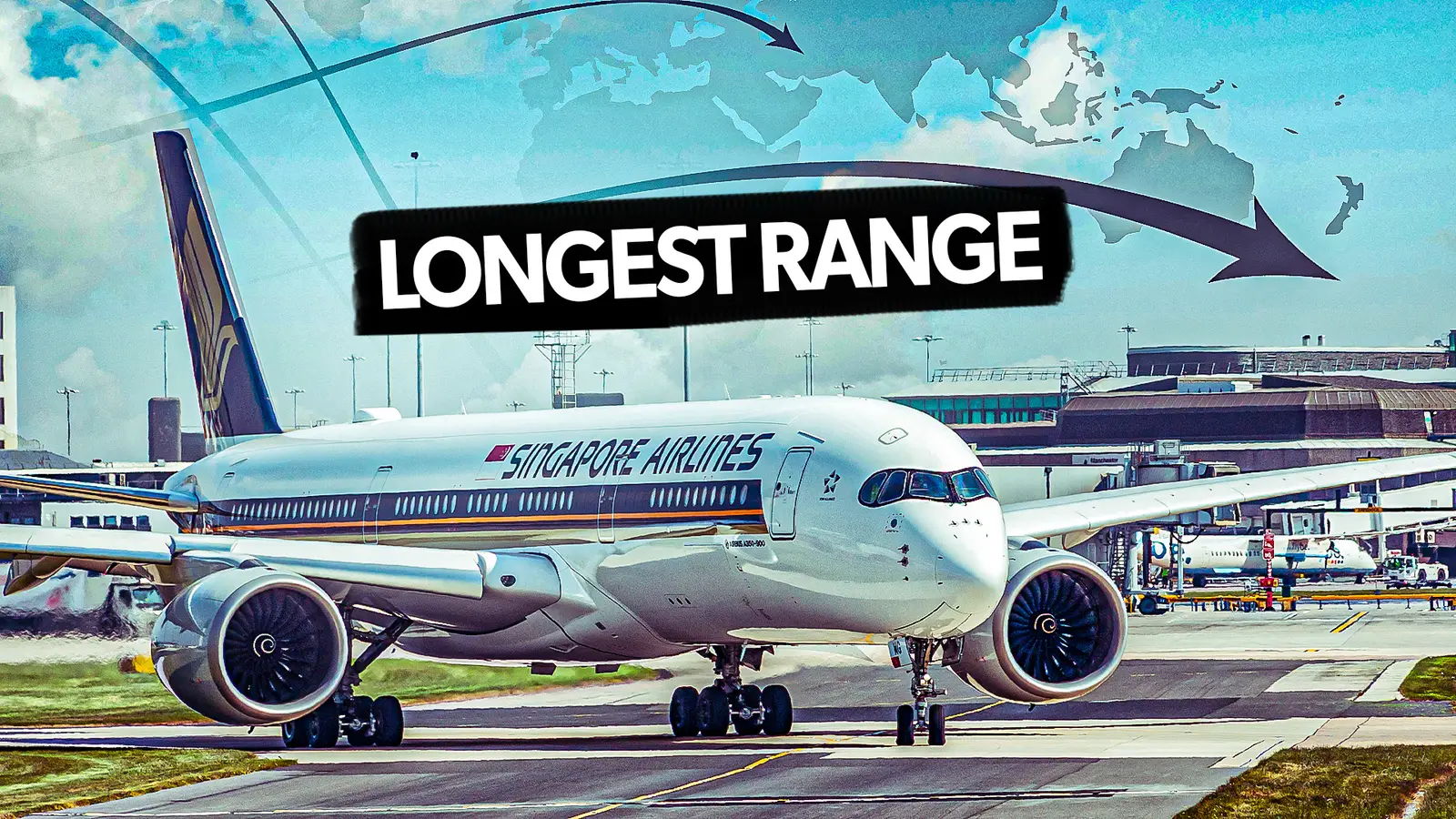
The two largest commercial aircraft manufacturers, Airbus and Boeing, compete to gain market share when it comes to aircraft sold and the type of aircraft produced, which is influenced by customer (in this case, the airlines) needs. In the past decade, the need for most long-haul operators has been for an efficient long-range aircraft, suited for point-to-point operations.
To cater to this demand, Airbus devised the A350 program, while Boeing launched the 787. Both are clean-sheet designs, equipped with the latest technology, created with advanced materials, and powered by efficient powerplants. However, for the airlines, it became a game of top trumps when it came to choosing which aircraft to go for. When comparing metrics, it soon became clear that Airbus was winning when it came to operational range.
The A350 Is The Long Range Leader
Entering service in 2016, the Airbus A350 family was the latest generation of wide-body aircraft from the European manufacturer, and, even though it was five years after Boeing’s 787 entered commercial service, the competition was robust from the beginning. With many operators focusing on point-to-point operations rather than hub-and-spoke at the time, a key market demand among long-haul airlines was the need for an efficient twin-engined aircraft with long-range credentials.
The Boeing 787 family variants met these conditions and were Boeing’s most efficient widebodies. However, different variants of the family were outperformed in certain metrics by their own predecessor: the popular Boeing 777-300ER. While the different variants can cater to different market sizes and provide airlines with the ability to right-size their operations, the range offered by these new aircraft was still lower than that of the 777-300ERs (with the 787-9 being the exception).
The above tables show a clear comparison of the operational metrics of these aircraft. The A350, just like the 787s, is a clean-sheet and efficient twin-engined aircraft, but with longer range and higher passenger capacity. Airbus, clearly proud of the range it offers with the A350, markets the aircraft as ‘The Long Range Leader.’ Despite the impressive range, Airbus proceeded to beat this with the (limited) production of the A350-900 ULR, which currently operates the world’s longest route.
Is Boeing Concerned?
The short answer is quite possibly yes, but perhaps not for the most obvious reasons. The 787, despite having a few issues over the years, is popular and successful in sales. As of the end of August 2025, Boeing has received 2,671 orders for the Dreamliners, with a backlog of 991 aircraft, while Airbus has logged 1,435 A350 orders (65 are for the A350F), with a backlog of 761 aircraft. The US manufacturer has since scored an order from Turkish Airlines for up to 75 more 787s.
A reason why Boeing could potentially be worried is that the A350s outperform the Dreamliners when it comes to operational range, and even with the upcoming Boeing 777X, things do not get any better. While the 777X provides the efficiency to compete with the A350 and even exceeds it in terms of capacity (depending on the configuration), the aircraft still falls short on range. The 777-8 exceeds the range of the A350-900, but falls short of the A350-1000 when it comes to range and capacity.
This is not an issue at the moment, because very few airlines currently operate sectors of such length. However, in recent years, this has been increasing, as airlines grow, networks expand, and many carriers now wish to compete with hub-and-spoke operators by offering direct flights between cities. For such ultra-long-haul flights, every bit of additional range matters, and thus the A350 will always win over a Boeing aircraft for such operations, leading to a market segment dominated by Airbus.
Additionally, because of the long certification processes required to build an entirely new aircraft, it will be difficult for Boeing to build a new clean-sheet aircraft to compete with the A350s when it comes to range. As such, this leaves the manufacturer with the only option of creating another 787 variant with extended range, to avoid major certification processes of a totally new aircraft. Even then, such an aircraft would have to compete with the Airbus A350-900ULR.
The Ultra-Long-Range Model
Two years after entering into service, Airbus delivered the first of seven modified A350-900s to Singapore Airlines. The modified version was called the A350-900ULR, and as the name suggests, these are Ultra-Long-Range versions of the -900, and push the operational range of the aircraft from 8,500 NM to 9,700 NM. This allows the airline to operate the longest direct flights in the world, from Singapore to New York, with a distance of 9,000 NM and a flight time of 18 hours and 45 minutes.
Despite this extended range, Australian carrier Qantas chose to go with Airbus’ A350-1000 model for its Project Sunrise, to provide direct connectivity between Eastern Australia and Western Europe. This is a perfect example of why Boeing could be worried, because Qantas had a choice of the 787 and the A350 for the project, and eventually proceeded to order 12 examples of the latter. This is because the airline wanted the range, but also the capacity, without compromising one for the other.
Ultimately, Boeing does not have an aircraft that can effectively cater to this specific market segment, in competition with the offerings of the A350 family. Additionally, with the commitments and current backlog for the (yet to be certified) 737 MAX 7, 737 MAX 10, and the 777X family aircraft, Boeing cannot really start working on another variant of the 787s or a clean-sheet aircraft with longer range.
The Longest Routes
The table below details, as of July, what FlightRadar24 reports to be the longest non-stop flights in the world. It is worth noting that the Qatar Airways DOH-AKL flight was temporarily switched to the Boeing 777-200LR, but was originally operated by the A350-1000. Furthermore, Air India’s BLR-SFO service has been temporarily suspended along with a few of the carrier’s other long-haul flights.
As seen above, the 10 longest flights see their fair share of A350 and 787 flights. However, it is the A350 that sits at the top of the list, and with Qantas’ Project Sunrise on the horizon, the dominance of the A350 at the top of the chart will only continue to increase.
Some Airlines Bet On Both
For carriers who are not too concerned about ultra-long-range flights or have a variety of destinations within their network, either aircraft type can be attractive depending on their operations. In fact, some carriers have both types within their fleet/orders, because depending on the operations, the 787s and the A350s can complement each other. These include major carriers such as Singapore Airlines, Qatar Airways, Lufthansa, British Airways, Etihad, and many more.
The reason for such popularity for these two aircraft types is that, essentially, they are both highly efficient, latest-generation widebody aircraft, and, because of the varying demand across the markets worldwide, each route will have a suitable aircraft. Having both aircraft families within the fleet will allow the airline to right-size its operations depending on the route and seasonality.
Furthermore, without any other long-haul aircraft currently being designed or planned, any airline looking for an efficient long-haul aircraft for its future network expansion will pick between the A350 and 787 (and the 777X). Thus, it is a real possibility that going forward, these aircraft types will receive more orders, and airlines operating one could easily order the other depending on their respective expansion plans.
Some Are Betting On All Three
Despite the significant delay in the entry into service of the 777X, the type has amassed a sizable order from a few operators, who, upon receiving the aircraft type, will then operate all three types of the latest generation aircraft. This would include airlines such as Lufthansa, Singapore Airlines, Qatar Airways, Etihad, Emirates (which has the 777X and 787s on order), and more.
The Boeing 777X family aircraft is the updated iteration of the popular 777 program. Apart from the 777s, the 777X family will also offer a suitable and efficient replacement for Boeing’s 747s and Airbus’ A380s that are operated by airlines focusing on a hub-and-spoke model, for whom capacity is usually more important than range. This is more evident when looking at the airlines that have ordered the 777X, which include carriers such as Emirates, Singapore Airlines, and British Airways.
These airlines focus on connecting traffic through their hubs and currently operate the A380 or the 747. Ultimately, Boeing’s 787 program is a success and extremely popular, with the manufacturer bound to see more orders of the type come in, as airlines are looking to expand their fleet to cater to their growing networks or replace their aging fleet. However, it is unlikely they can capture any effective market share in the ultra-long-range segment because of the economics offered by the A350 family.



